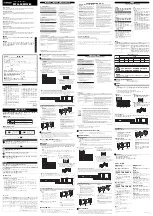
24 |
Baker Hughes
© 2020 Baker Hughes Company. All rights reserved.
Figure 10
If the correct position of the adjusting rings (as measured
in the disassembly procedure (see Section X) is not
known, the valve adjusting rings may be positioned using
the information in Table 10.
The lower ring may be positioned by turning the lower
adjusting ring up until it contacts the disc. After choosing
the appropriate orifice size, turn the adjusting ring down
the corresponding number of notches listed in the “Lower
Ring” column. Then, replace the adjusting ring pin. The
adjusting ring must be free to move both directions, but
not rotate.
The upper ring may be positioned by turning the upper
adjusting ring down towards the nozzle bushing, until it
becomes level with the bottom of disk. Then after choosing
the appropriate orifice size, turn the adjusting ring down the
corresponding number of turns (360°), listed in the "Upper
Ring" column. Then replace the adjusting ring pin. The
adjusting ring must be free to move both directions, but not
rotate.
The adjusting rings are now in a starting position for
full lift steam testing. These adjusting ring settings will
generally provide a blowdown greater than required by
Section I of the ASME Code, and should be adjusted
for the particular application.
C. Presetting the Adjusting Rings
B.2 Application of Test Gags (All Pressures)
1. Refer to Figures 1 & 2 on Section VIII. Remove lever pin and lever. Then
loosen cap screw and remove cap.
2. Center the test gag screw in the exposed end of the spindle and hook the
legs of gag under the sides of the yoke as shown in Figure 10.
Do not apply the gag load until the boiler hydrostatic pressure is equal
to 80 percent of the pressure to which the low set valve is adjusted.
3. Apply the gag load by turning the gag screw clockwise. If the gag on any
valve has not been tightened sufficiently, the valve will leak.
If this occurs, the hydrostatic test pressure should be reduced until the
valve becomes tight and then the gag should be tightened still further.
This procedure must be followed exactly since it is very difficult to stop the
leak by additional gagging once it has started. Any attempt to pinch off the
leakage through the valve without first lowering the hydrostatic pressure
may result in damage to the valve seats.
4. After the hydrostatic test is completed, the gags should be removed when
the hydrostatic pressure has been reduced to 85 percent to 90 percent of
the low set valve.
Under no circumstances should the gags be left on valves with no
hydrostatic pressure on the system.
XIV. Setting and Testing (Cont’d)









































